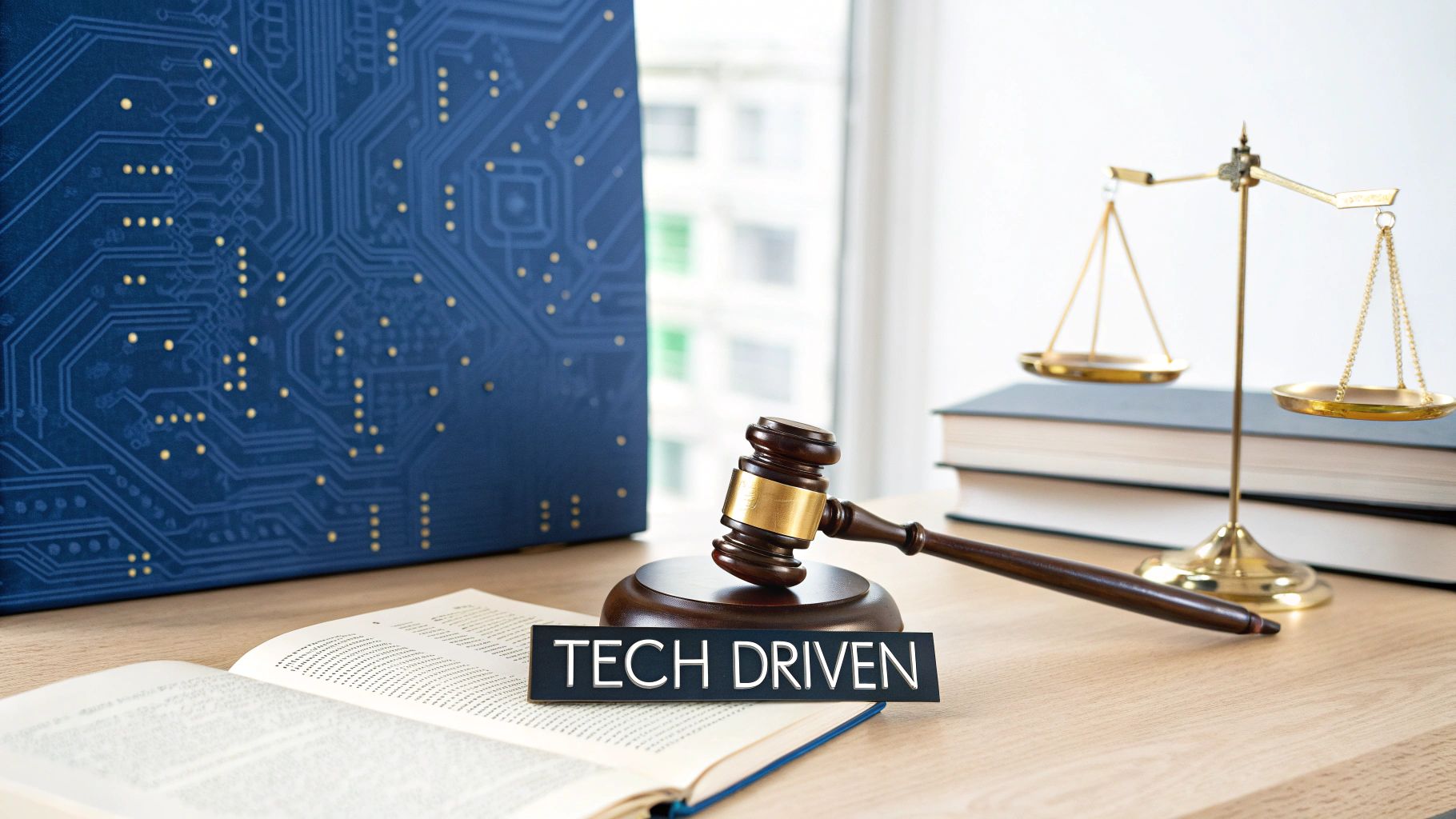Boost Efficiency with Legal Document Automation
Demystifying Legal Document Automation for Practitioners

Legal document automation is reshaping the legal profession. It signifies a move beyond simple document storage and towards tools designed specifically for legal work. Many firms mistakenly believe general document solutions offer sufficient automation. This often results in unmet expectations and frustration.
True legal document automation transforms key workflows. Think about generating complex contracts, preparing court filings, and creating comprehensive compliance documentation in a fraction of the time. With the right automation solution, this becomes a reality. This increased efficiency allows attorneys to focus on strategic legal work instead of tedious administrative tasks.
Understanding the Core Technologies
Effective legal document automation depends on a combination of technologies. Template systems are fundamental, enabling the rapid creation of standardized documents. Modern solutions go further, incorporating machine learning. This allows for document analysis, identifying potential issues, and even predicting outcomes. The best technology choice depends on the specific needs of each legal practice.
The legal document automation software market is growing rapidly. Projections show it reaching multi-billion dollar valuations by the mid-2030s. This growth is fueled by increasing regulatory demands and the digitization of legal practices. North America currently leads adoption due to factors like high law firm density and established legal tech ecosystems. More statistics are available from Business Research Insights.
Key Benefits for Practitioners
Legal document automation offers numerous advantages for legal professionals:
- Increased Efficiency: Automate repetitive tasks, freeing up time for more strategic work.
- Reduced Errors: Minimize human error through automated data entry and document generation.
- Improved Compliance: Ensure documents comply with regulatory requirements through automated checks.
- Enhanced Client Experience: Provide faster turnaround times and better communication.
These benefits contribute to a more efficient and profitable practice. For more information, check out our guide on Modern Legal Solutions for Law Firm Document Management. Implementing the right automation tools helps firms streamline operations and better serve clients. This improves client satisfaction and creates a stronger competitive edge. Understanding the difference between basic document management and true legal document automation is crucial for realizing the full potential of these technologies.
The Real ROI: What Legal Document Automation Actually Delivers

Beyond the hype, what tangible returns does legal document automation offer? This section provides a framework for assessing the return on investment (ROI) of implementing these systems. We'll explore both the immediate and long-term benefits grounded in real-world results.
Measuring the Immediate Impact
Implementing legal document automation offers instant advantages. A primary benefit is the impact on staffing. Automating routine tasks reduces administrative overhead, leading to potential cost reductions. Error reduction is another key benefit. Automated systems minimize human error during document creation, mitigating the risk of costly mistakes.
Document automation tools like Parserr are delivering measurable efficiency gains. Law firms using automation for contract creation report saving up to 82% of manual processing time. This translates to hundreds of hours saved annually for mid-sized firms, boosting capacity and profitability. These tools now commonly manage tasks like redlining and version control, further minimizing errors. For best practices in document management, see this helpful guide: How to master document management best practices.
Calculating Long-Term Value
The long-term value of legal document automation goes beyond immediate cost savings. A significant factor is the opportunity cost of attorney time. By automating routine document creation, attorneys can focus on high-value, revenue-generating work. Improved client satisfaction is another important benefit, resulting from faster turnaround times and increased accuracy.
Presenting a Compelling Business Case
Building a business case for legal document automation requires quantifiable metrics. Present data on cost savings from reduced staffing and fewer errors. Highlight the increased revenue potential from freeing up attorney time. Emphasize improvements in client satisfaction and the firm’s enhanced competitive advantage. These tangible benefits resonate with firm leadership.
To further illustrate the financial benefits, let's consider the following table:
Introduction to Table: The table below provides a detailed comparison of time and cost savings achieved through legal document automation across various document types. This data highlights the significant efficiency gains and financial advantages that automation can bring to a legal practice.
| Document Type | Manual Processing Time | Automated Processing Time | Time Saved (%) | Annual Cost Savings ($) |
|---|---|---|---|---|
| Contracts | 8 hours | 1.44 hours | 82% | $10,000 |
| Closing Documents | 4 hours | 2 hours | 50% | $7,500 |
| Document Review | 10 hours | 3 hours | 70% | $15,000 |
Conclusion of Table: As the table demonstrates, legal document automation delivers substantial time and cost savings across different document types. These savings contribute directly to improved firm profitability and allow for a greater focus on high-value legal work.
Practical ROI Examples
Let’s examine specific examples: A real estate firm using automation can process closing documents 50% faster, increasing their transaction volume. A litigation firm might reduce document review time by 70%, enabling them to prioritize case strategy. These examples showcase the practical impact of legal document automation on a firm’s bottom line.
Choosing Your Legal Document Automation Platform: A Decision Framework

Finding the right legal document automation platform can be daunting with so many options available. This section offers a structured approach to evaluating these platforms, prioritizing your specific needs over marketing hype. It provides a practical framework for navigating the decision-making process.
Identifying Practice-Specific Requirements
Start by clearly defining your firm’s needs. Different areas of law, like litigation and transactional work, require unique document automation features. A litigation firm, for example, might prioritize streamlined court filings, while a transactional practice focuses on efficient contract generation. Think about the types of documents you frequently create and the challenges you face in managing them.
Also, consider your firm's size and current technology. Smaller firms often prioritize ease of use and affordability. Larger firms, on the other hand, might need enterprise-grade features and seamless integrations with existing systems like their Customer Relationship Management (CRM) or Practice Management Software (PMS). This initial assessment is key to a successful selection process.
Evaluating Mission-Critical Features
After identifying your needs, evaluate platforms based on essential features. Template customization is crucial for adapting the software to your document formats and legal requirements. Integration with your existing PMS ensures a smooth data flow and eliminates duplicate entry.
Security certifications are also paramount. Protecting sensitive client data requires a platform that adheres to industry standards, offering robust encryption and access controls. Consider jurisdiction-specific compliance, especially if your practice spans multiple jurisdictions.
Conducting Meaningful Trials and Negotiations
Don't just rely on vendor demos. Run thorough trials that mimic real-world scenarios in your practice. This helps assess the platform’s usability and effectiveness in your specific environment. Have your team use the platform to create and manage the documents they handle daily.
Staff involvement is essential for successful implementation. Address any resistance to new technology by highlighting the benefits of automation and providing sufficient training. This fosters buy-in and ensures a smoother transition. Finally, negotiate favorable terms with vendors based on your firm's size and needs, covering pricing, contract length, and support agreements.
Key Features To Look For
To help you compare various platforms, the table below summarizes key features to consider:
Feature Comparison of Top Legal Document Automation Solutions Comprehensive comparison of features, pricing, and suitability across leading legal document automation platforms
| Platform | Best For | Key Features | Integration Capabilities | Starting Price | User Rating |
|---|---|---|---|---|---|
| Example Platform A | Small to medium-sized firms | Template customization, e-signatures, workflow automation | Limited PMS integrations | $50/user/month | 4.5/5 |
| Example Platform B | Large firms | Advanced automation, robust reporting, API access | Extensive PMS integrations | $100/user/month | 4.0/5 |
| Example Platform C | Solo practitioners | Basic document assembly, simple interface, affordable | Limited integrations | $20/user/month | 3.5/5 |
This table highlights the importance of aligning your specific requirements with the platform's capabilities and pricing. Choosing the right platform can significantly improve your firm’s efficiency and ROI.
Implementation Strategies That Overcome Firm Resistance

Even with the best legal document automation software, implementation can be challenging. Securing buy-in from every team member is critical for success. This involves addressing resistance and ensuring a smooth transition. This section offers a practical guide for implementing legal document automation effectively. You might be interested in: How to master workflow automation.
Converting Your Existing Document Library
Begin by converting your existing documents into reusable templates. This provides a familiar starting point for your team and maintains current workflows. Establish clear naming conventions for these templates. Intuitive names simplify the process of finding and using the correct templates, preventing confusion and unnecessary duplicates.
For example, use descriptive names like "Real Estate Closing - Residential" or "Litigation - Motion to Dismiss." This clarity will save time and reduce frustration for everyone involved in the document creation process.
Establishing Effective Workflows and Training
Implement approval workflows to maintain quality control. This ensures documents are reviewed before being finalized, preserving accuracy and compliance. For instance, a senior attorney could review contracts before they are sent to clients.
In addition, provide thorough training to all team members. Addressing any concerns about technology changes directly will reduce resistance and encourage adoption. This proactive approach will help your team feel comfortable and confident using the new system.
Addressing Common Implementation Pitfalls
Several common problems can hinder successful implementation. Template sprawl happens when too many similar templates are created, causing confusion and inefficiency. Permission headaches occur when access controls are not configured correctly, impacting document security and collaboration. Version control nightmares arise when multiple versions of the same document are in circulation, potentially leading to errors and inconsistencies.
Address these challenges proactively. Establish a system for managing templates, ensuring only necessary ones are created and maintained. Clearly define user roles and permissions to guarantee appropriate document access. Utilize the version control features within your legal document automation software to track changes and maintain a single source of truth.
Scalable Implementation Models and Success Stories
Different firms have different needs. Smaller firms can often implement automation incrementally, perhaps starting with one specific practice area. Larger firms may opt for a phased rollout across various departments. Regardless of firm size, prioritizing user training and clear communication is crucial for success.
Learning from others' experiences is invaluable. One mid-sized firm successfully implemented automation by training paralegals first. This created a group of internal champions who then helped train attorneys, resulting in widespread adoption. Another firm increased efficiency by 90% after converting their most frequently used documents into templates, showcasing the tangible benefits of automation. By following these practical strategies and learning from successful implementations, your firm can overcome resistance and realize the full potential of legal document automation.
Beyond Basics: Advanced Legal Document Automation Strategies
Moving beyond simply filling in templates, forward-thinking law firms are leveraging legal document automation to gain a competitive edge. Implementing advanced strategies can yield significant returns. This section explores these applications and their impact on efficiency and client satisfaction.
Conditional Logic in Complex Agreements
One advanced strategy involves incorporating conditional logic into document templates. This allows automated documents to adapt based on the information entered by the user. For instance, a contract template can automatically adjust clauses based on specifics like the deal's jurisdiction or the type of transaction. This automation saves time and reduces errors by removing the need for manual edits, ensuring accuracy and relevance in complex agreements.
Automated Compliance and E-signatures
Another key strategy is automated compliance checking. Legal document automation software can be configured to verify compliance with current regulations. This proactive approach minimizes the risk of penalties and ensures documents adhere to the latest standards.
Integrating legal document automation with e-signature platforms like DocuSign streamlines the signing process, doing away with the need for printing, scanning, and physical signatures. This saves time and improves the client experience. Clients can sign documents electronically from anywhere, accelerating transactions and boosting efficiency.
Client-Facing Portals and End-to-End Workflows
Leading firms are implementing client-facing document portals, providing clients with secure online access to review and manage their documents. This increased transparency enhances communication and strengthens client relationships. This self-service approach empowers clients while freeing up valuable staff time. Read also: Your guide to AI legal software.
Innovative legal teams are also developing end-to-end workflows through legal document automation. These workflows connect every step, from client intake to final billing. This integration minimizes manual data entry and ensures consistency throughout the entire process. This, in turn, reduces administrative overhead and improves overall operational efficiency. For example, information gathered during client intake can automatically populate relevant documents, eliminating redundant data entry and saving significant amounts of time.
Use Cases Across Legal Practices
These advanced strategies find applications in a variety of legal practices. In litigation, automation can generate court filings and manage discovery documents. In transactional practices, it automates contract creation and due diligence processes. And for compliance, automation generates reports and manages regulatory filings.
These diverse examples highlight the broad applicability of legal document automation. Leading firms are making it a cornerstone of their digital transformation strategies. By embracing these advanced strategies, law firms can substantially improve both efficiency and client satisfaction. The ability to quickly adapt to changing regulations and client needs enables firms to offer more responsive and efficient service. This translates to a stronger competitive advantage and better client relationships, ultimately driving growth and profitability.
The Future of Legal Document Automation: Trends Worth Watching
Legal document automation is a constantly evolving field. Staying informed about the latest advancements is essential for any firm seeking a competitive edge. This section explores emerging trends shaping the future of legal document automation, drawing on insights from industry experts and investment patterns.
The Rise of Artificial Intelligence
Artificial intelligence (AI) is rapidly transforming how legal professionals approach document automation. Artificial intelligence (AI) goes beyond simply filling in templates. It now handles complex tasks such as contract analysis and creation. AI can identify missing clauses, flag potential risks, and even suggest alternative language, dramatically accelerating the drafting process. This integration of AI marks a significant advancement, shifting from basic automation to intelligent assistance. For a deeper dive into this topic, see: Learn more about AI in legal practice.
Blockchain for Enhanced Security
Blockchain technology, known for its security and transparency, holds immense potential for legal document automation. It enables secure document verification and chain of custody tracking. This is particularly crucial for sensitive legal documents requiring strict authenticity and tamper-proofing. Although still in its early stages of adoption in the legal field, blockchain's potential to revolutionize document security merits close attention.
Empowering Users With No-Code Platforms
The emergence of no-code platforms is democratizing access to legal document automation. These platforms allow non-technical users to create sophisticated document workflows without coding experience. This empowers legal professionals to customize automation solutions to their specific needs, offering greater flexibility and control over document creation processes. This trend is especially beneficial for smaller firms or those without dedicated IT staff, enabling them to utilize automation without substantial technical investments.
Navigating the Hype Cycle
While these emerging technologies offer exciting possibilities, it's important to distinguish between hype and practical application. Not every trend necessitates immediate investment. For instance, while blockchain provides robust security, its widespread adoption in legal document automation may still be on the horizon. Focus on identifying the trends that best align with your firm's unique requirements and strategic objectives.
Future-Proofing Your Automation Investments
To ensure your firm's investment in legal document automation remains valuable over time, adopt a strategic approach. Regularly evaluate your current technology and pinpoint areas for improvement. Develop an innovation roadmap that aligns with your firm’s long-term goals. This involves staying updated on emerging technologies and assessing their potential impact on your practice. By embracing a proactive and forward-thinking mindset, your firm can remain at the cutting edge of legal document automation, maximizing efficiency and client satisfaction.
Ready to experience the future of document creation? Whisperit, an AI-powered dictation and text editing platform, helps legal professionals create and manage documents up to two times faster. With features like secure Swiss hosting, GDPR compliance, and seamless template customization, Whisperit optimizes workflows while prioritizing security and privacy. Visit Whisperit today to learn more and transform your document processes.